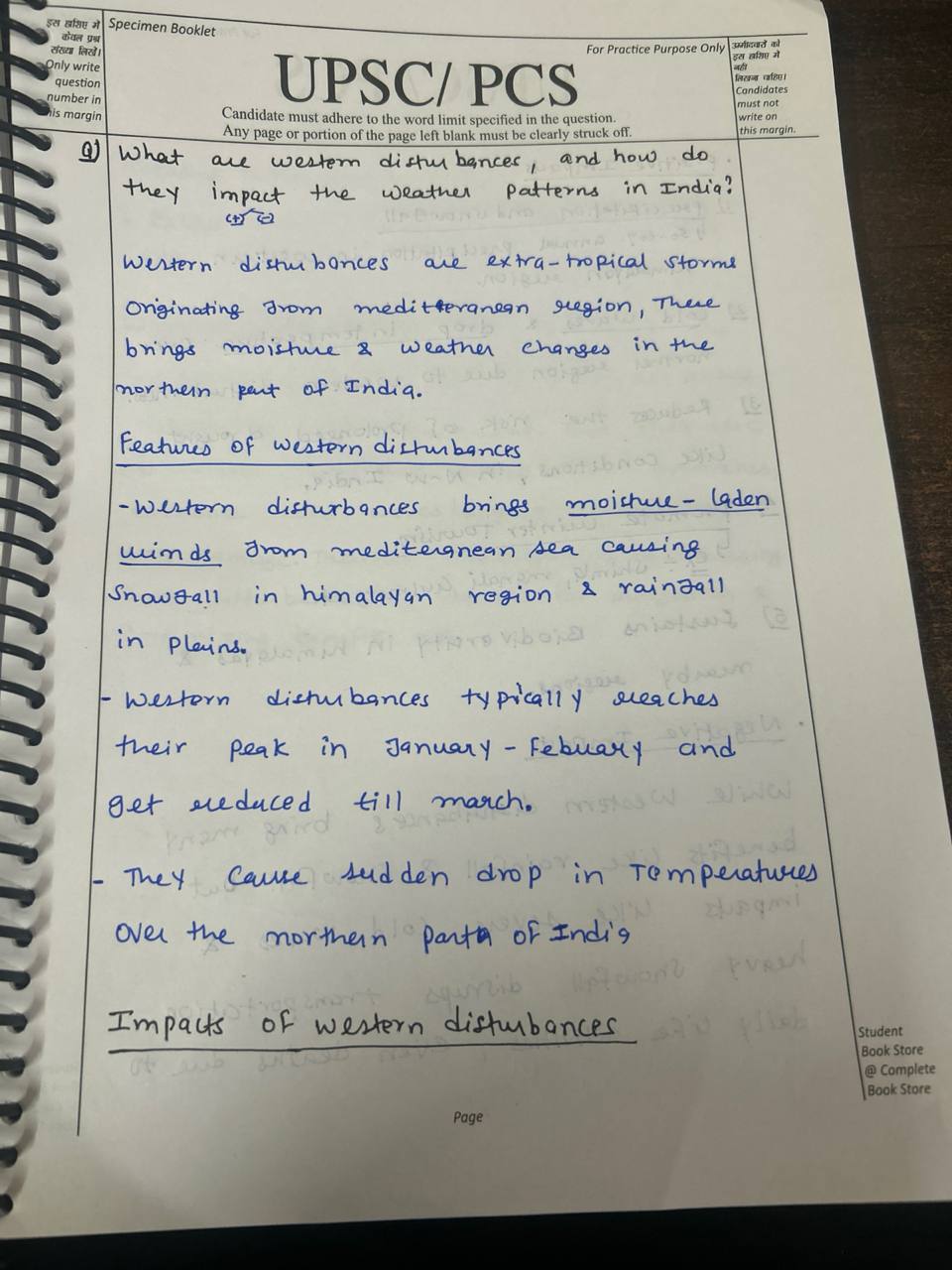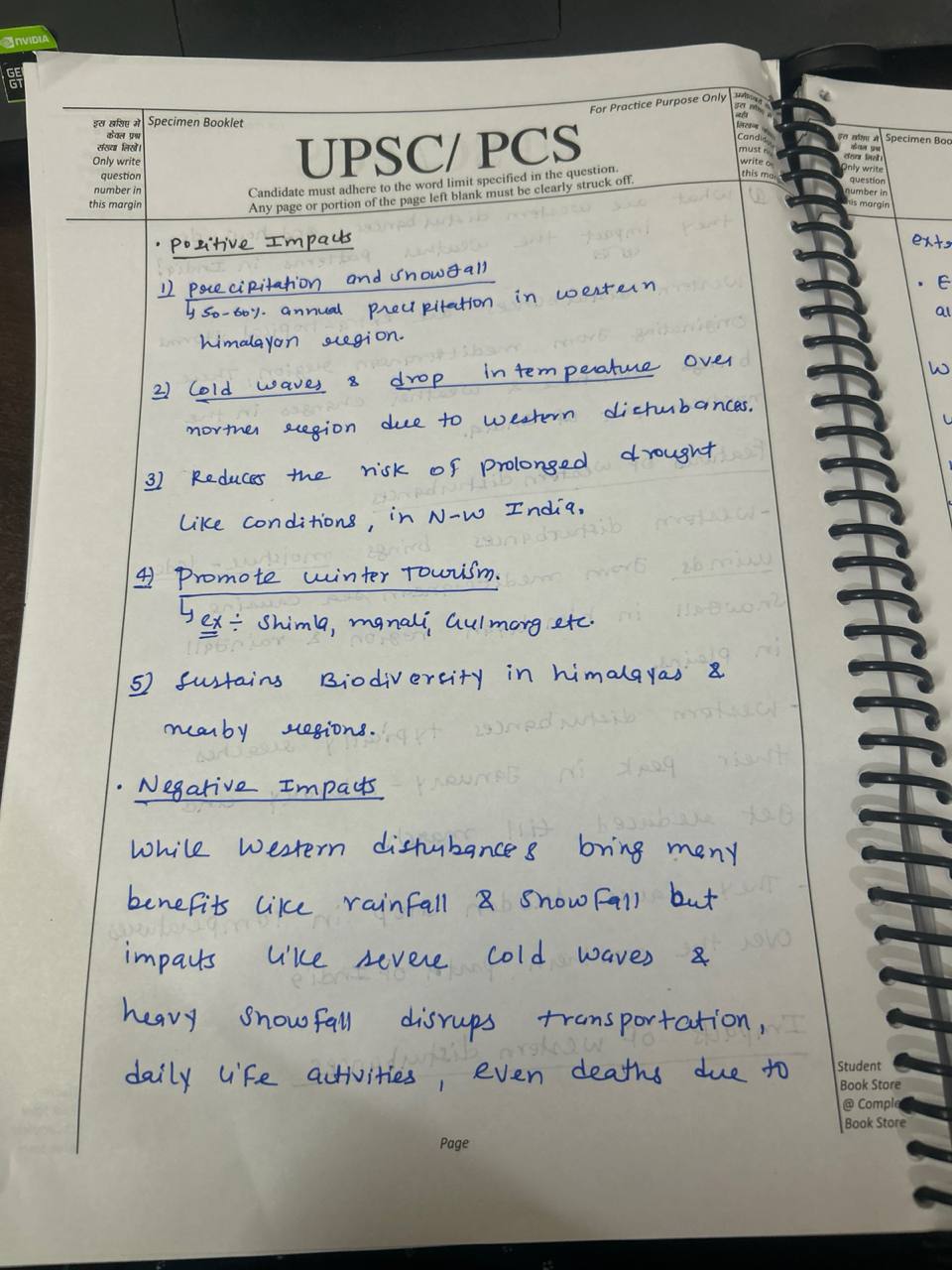Home/upsc: climate
- Recent Questions
- Most Answered
- Answers
- No Answers
- Most Visited
- Most Voted
- Random
- Bump Question
- New Questions
- Sticky Questions
- Polls
- Followed Questions
- Favorite Questions
- Recent Questions With Time
- Most Answered With Time
- Answers With Time
- No Answers With Time
- Most Visited With Time
- Most Voted With Time
- Random With Time
- Bump Question With Time
- New Questions With Time
- Sticky Questions With Time
- Polls With Time
- Followed Questions With Time
- Favorite Questions With Time

Examine the spatial and temporal variations in the distribution of precipitation across India and identify the factors that contribute to these variations. (200 words)
Model Answer Introduction India experiences a highly variable distribution of precipitation, with significant spatial and temporal differences across the country. Around 80% of the nation's annual rainfall occurs during the monsoon season, which plays a crucial role in agriculture and water resourceRead more
Model Answer
Introduction
India experiences a highly variable distribution of precipitation, with significant spatial and temporal differences across the country. Around 80% of the nation’s annual rainfall occurs during the monsoon season, which plays a crucial role in agriculture and water resources. However, rainfall varies from over 400 cm in the northeastern states to less than 10 cm in arid regions like Rajasthan. Various factors, such as geographical location, monsoon systems, and topography, contribute to these variations.
Spatial Variations
Temporal Variations
Factors Contributing to Variations
Conclusion
Understanding the spatial and temporal variations in precipitation is crucial for managing India’s water resources and adapting to climate change. By analyzing these patterns, India can implement better strategies for water conservation and sustainable development.
See lessHow do the Western Ghats affect the South-West monsoon in the coastal regions of South-West India?(200 Words)
Model Answer Barrier Effect The Western Ghats serve as a significant barrier to the monsoonal winds that arrive from the southwest. As these winds encounter the mountains, they are forced to rise, resulting in orographic rainfall. This effect leads to substantial precipitation in the region, with 65Read more
Model Answer
Barrier Effect
The Western Ghats serve as a significant barrier to the monsoonal winds that arrive from the southwest. As these winds encounter the mountains, they are forced to rise, resulting in orographic rainfall. This effect leads to substantial precipitation in the region, with 65% to 80% of annual rainfall occurring between June and September (Source: meteorological studies).
Gaps in the Western Ghats
Despite their overall barrier function, the Western Ghats feature gaps that allow rain-bearing winds to pass through with less precipitation. A notable example is the Palghat Gap, which is approximately 30 kilometers wide and located between the Nilgiri and Anamalai Hills in Kerala. This gap enables winds to cross over to the leeward side, leading to reduced rainfall in the immediate coastal areas (Source: geographic studies).
Variations in Mountain Topography
The topography of the Western Ghats varies significantly. In Karnataka, the broader mountains compel rain-bearing winds to travel greater distances, allowing more time for moisture to coalesce and resulting in higher rainfall (Source: hydrological analyses).
Increased Convection
The gentle slopes of the Karnataka Western Ghats absorb more sunlight, promoting greater convection compared to the steeper slopes found in Maharashtra and Kerala. This enhanced convection contributes to increased rainfall in these areas (Source: climate studies).
Distance from Peak
Interestingly, areas of heavy rainfall are often found up to 50 kilometers away from the mountain peaks. This phenomenon occurs because the distance allows for better moisture accumulation in cloud formations (Source: meteorological research).
Cyclones
Additionally, the Arabian Sea has seen more frequent cyclones in recent years during the onset of the South-West monsoon. The Western Ghats act as a barrier for these cyclonic storms, reducing their intensity and protecting the coastal regions of India (Source: climatological studies).
In summary, the Western Ghats significantly regulate South-West monsoonal rainfall in India’s coastal regions through orographic lifting, variations in topography, and their role in influencing cyclonic activity.
See lessWhat is tropical monsoon climate? Discuss its distribution and explain the process of its onset in the Indian subcontinent. (200 words)
Model Answer Tropical Monsoon Climate The tropical monsoon climate is marked by a seasonal reversal of winds and corresponding changes in precipitation. It is characterized by: Temperature: Monthly mean temperatures above 18°C, with summer temperatures ranging from 30-45°C and winter temperatures beRead more
Model Answer
Tropical Monsoon Climate
The tropical monsoon climate is marked by a seasonal reversal of winds and corresponding changes in precipitation. It is characterized by:
Distribution
This climate is found in regions of the Indian subcontinent, Southeast Asia, parts of South America, and northern Australia, notably in countries like India, Burma, Thailand, and Vietnam (Source: Global Climate Distribution).
Onset in the Indian Subcontinent
The Indian monsoon begins in June, driven by factors such as:
The process culminates in rainfall across the subcontinent from June to September.
See lessWhat are local winds? Provide examples and explain how they influence the climate of a region. (200 words)
Model Answer Local Winds Local winds are winds that blow over a small geographical area, typically covering distances from tens to a few hundred kilometers. They are usually short-lived, lasting only several hours to a day, and are influenced by local geographic features like landforms and weather pRead more
Model Answer
Local Winds
Local winds are winds that blow over a small geographical area, typically covering distances from tens to a few hundred kilometers. They are usually short-lived, lasting only several hours to a day, and are influenced by local geographic features like landforms and weather patterns.
Examples of Local Winds and Their Climate Impact
Conclusion
Local winds can significantly affect the climate by altering temperature, humidity, and precipitation patterns, which in turn influences agriculture and daily life.
See lessWhat are western disturbances, and how do they impact the weather patterns in India? (200 words)



See lessDiscuss the implications of extreme weather events on disaster management strategies in India.
Extreme weather events, such as cyclones, floods, droughts, and heatwaves, have profound implications for disaster management strategies in India. These events can strain existing systems and necessitate a range of adaptive measures to mitigate their impact and enhance resilience. Here’s a detailedRead more
Extreme weather events, such as cyclones, floods, droughts, and heatwaves, have profound implications for disaster management strategies in India. These events can strain existing systems and necessitate a range of adaptive measures to mitigate their impact and enhance resilience. Here’s a detailed discussion on how extreme weather events influence disaster management strategies in India:
1. Enhanced Preparedness and Planning
1.1. Risk Assessment and Mapping
1.2. Contingency Planning
2. Infrastructure and Resilience Building
2.1. Climate-Resilient Infrastructure
2.2. Urban and Rural Planning
3. Response and Recovery
3.1. Immediate Response
3.2. Recovery and Rehabilitation
4. Policy and Governance
4.1. Institutional Framework
4.2. Legal and Regulatory Measures
5. Community Engagement and Awareness
5.1. Public Education
5.2. Local Knowledge
6. Climate Change Considerations
6.1. Adaptation Measures
Conclusion
Extreme weather events significantly impact disaster management strategies in India. They highlight the need for enhanced preparedness, resilient infrastructure, effective response and recovery mechanisms, and robust policy frameworks. Addressing these implications through comprehensive planning, community engagement, and integration with climate adaptation strategies can improve the country’s ability to manage the impacts of extreme weather events and enhance overall resilience.
See lessEvaluate the role of traditional knowledge in adapting to climate variability among rural communities in India.
Traditional knowledge plays a crucial role in helping rural communities in India adapt to climate variability. This knowledge, passed down through generations, encompasses practices, beliefs, and techniques developed through long-term observation and interaction with the local environment. Here’s anRead more
Traditional knowledge plays a crucial role in helping rural communities in India adapt to climate variability. This knowledge, passed down through generations, encompasses practices, beliefs, and techniques developed through long-term observation and interaction with the local environment. Here’s an evaluation of how traditional knowledge contributes to climate adaptation:
1. Agricultural Practices
1.1. Crop Selection and Diversification
1.2. Water Management
2. Livestock Management
2.1. Grazing Practices
2.2. Shelter and Feeding
3. Water Resources and Management
3.1. Local Water Bodies
3.2. Soil and Water Conservation
4. Early Warning Systems
4.1. Weather Prediction
5. Community and Cultural Practices
5.1. Festivals and Rituals
5.2. Knowledge Transmission
6. Integration with Modern Practices
6.1. Complementing Modern Technology
6.2. Policy and Support
Conclusion
Traditional knowledge is a valuable asset in adapting to climate variability among rural communities in India. It encompasses a range of practices related to agriculture, water management, livestock care, and early warning systems that have evolved over generations. This knowledge helps communities manage environmental challenges effectively and sustainably. Integrating traditional knowledge with modern practices and policies can enhance climate adaptation efforts, ensuring that rural communities are better equipped to face the impacts of climate change while preserving their cultural heritage.
See lessAnalyze the effectiveness of India's climate policies in addressing environmental challenges and promoting sustainable development.
India’s climate policies play a crucial role in addressing environmental challenges and promoting sustainable development. The effectiveness of these policies can be analyzed across several dimensions, including their scope, implementation, achievements, and areas for improvement. Here’s a comprehenRead more
India’s climate policies play a crucial role in addressing environmental challenges and promoting sustainable development. The effectiveness of these policies can be analyzed across several dimensions, including their scope, implementation, achievements, and areas for improvement. Here’s a comprehensive analysis:
1. Scope and Objectives
1.1. National Action Plan on Climate Change (NAPCC)
1.2. Key Missions
2. Achievements and Effectiveness
2.1. Renewable Energy Growth
2.2. Energy Efficiency
2.3. Afforestation and Green Cover
2.4. Climate Resilience and Adaptation
3. Implementation Challenges
3.1. Funding and Resources
3.2. Coordination and Integration
4. Policy and Regulatory Framework
4.1. Legislative Measures
4.2. International Commitments
5. Areas for Improvement
5.1. Enhanced Ambition
5.2. Implementation and Monitoring
5.3. Public Awareness and Participation
Conclusion
India’s climate policies, particularly the National Action Plan on Climate Change and its associated missions, have made notable progress in addressing environmental challenges and promoting sustainable development. Achievements in renewable energy, energy efficiency, and afforestation are commendable. However, challenges such as funding constraints, implementation gaps, and the need for enhanced ambition remain. Addressing these challenges requires continued efforts to strengthen policies, improve coordination, and engage stakeholders at all levels. By building on its successes and addressing areas for improvement, India can advance its climate goals and contribute to global sustainability efforts.
See lessDiscuss the role of climate in shaping regional disparities in development and infrastructure in India.
Climate plays a significant role in shaping regional disparities in development and infrastructure across India. The country’s diverse climatic conditions create varying challenges and opportunities that influence economic activities, infrastructure development, and overall regional development. HerRead more
Climate plays a significant role in shaping regional disparities in development and infrastructure across India. The country’s diverse climatic conditions create varying challenges and opportunities that influence economic activities, infrastructure development, and overall regional development. Here’s a detailed discussion on how climate impacts regional disparities in development and infrastructure:
1. Agriculture and Economic Activities
1.1. Agriculture Dependence
1.2. Economic Opportunities
2. Infrastructure Development
2.1. Construction and Maintenance
2.2. Urban Planning
3. Regional Disparities
3.1. Economic Disparities
3.2. Infrastructure Disparities
4. Adaptation and Resilience
4.1. Climate Adaptation
4.2. Policy and Planning
Conclusion
Climate significantly influences regional disparities in development and infrastructure across India. Favorable climatic conditions can enhance agricultural productivity, attract investment, and support robust infrastructure development, leading to more rapid regional development. Conversely, challenging climates can exacerbate disparities by creating obstacles to economic growth, increasing infrastructure costs, and limiting access to services. Addressing these disparities requires targeted adaptation strategies, resilient infrastructure planning, and region-specific policies to ensure balanced and sustainable development across the country.
See lessExamine the relationship between climate and the distribution of different ecosystems across India.
The distribution of different ecosystems across India is closely related to its diverse climate patterns, which vary significantly across the country. India's climate, influenced by factors such as latitude, altitude, and monsoon patterns, plays a crucial role in determining the types of ecosystemsRead more
The distribution of different ecosystems across India is closely related to its diverse climate patterns, which vary significantly across the country. India’s climate, influenced by factors such as latitude, altitude, and monsoon patterns, plays a crucial role in determining the types of ecosystems found in different regions. Here’s an examination of this relationship:
1. Tropical Rainforests
1.1. Climate Characteristics
1.2. Ecosystem Characteristics
2. Tropical Deciduous Forests
2.1. Climate Characteristics
2.2. Ecosystem Characteristics
3. Semi-Arid and Arid Regions
3.1. Climate Characteristics
3.2. Ecosystem Characteristics
4. Temperate Forests
4.1. Climate Characteristics
4.2. Ecosystem Characteristics
5. Alpine Meadows
5.1. Climate Characteristics
5.2. Ecosystem Characteristics
6. Mangrove Forests
6.1. Climate Characteristics
6.2. Ecosystem Characteristics
Conclusion
The distribution of ecosystems across India is intricately linked to the country’s diverse climate zones. From the tropical rainforests of the Western Ghats to the arid deserts of Rajasthan and the alpine meadows of the Himalayas, each ecosystem is adapted to its specific climatic conditions. These climatic factors influence vegetation types, fauna, and overall biodiversity, resulting in a rich and varied ecological tapestry. Understanding these relationships helps in conserving and managing India’s diverse ecosystems effectively.
See less